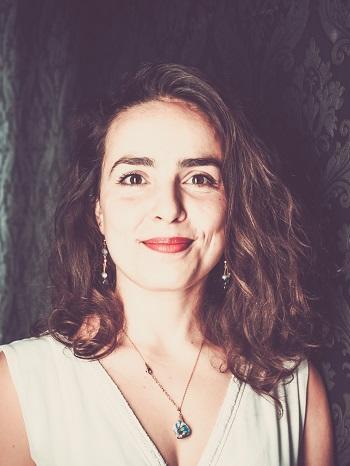Dr. Amel Bouder

Oct. 2023 – Mar. 2024
Deutsches Archäologisches Institut
Scholarships (most important):
04/2024 – 03/2025
The Fritz Thyssen Foundation Prize for the project "Iconography and epigraphy in context: The funerary and votive stelae of Mopth and Novar (2nd-4th c. AD)"
04/2023 – 09/2023
Fellow at the RomanIslam Center for the project "L’utilisation de matériaux luxueux en Afrique du Nord, durant l’antiquité tardive: le marbre entre importation et exploitation locale"
10/2022 – 03/2023
Fellow at the RomanIslam Center for the project "La réutilisation des statues et bas-reliefs romains dans les constructions tardo-antiques dans les villes de la Numidie. Traces d'une nouvelle apparence urbaine"
02 – 04/2022
Scholarship SSHN: "Séjour Scientifique de Haut Niveau" attributed by the French embassy in Algeria
10/2018 – 05/2019
French-Algerian collaboration grant, Profas B+ for doctoral studies
Organization of workshop and invited lecture
07/2024
Co-organisation of a workshop with Prof. Sabine Panzram and Dr. Stefan Ardeleanu at the RomanIslam centre, entitled "Nouvelles approches de la culture matérielle en Algérie romaine et tardive"
05/2023
Invited lecture: The circulation of images and deities in the Mediterranean during Roman antiquity, Decentering the Mediterranean, Getty Foundation seminar at the American Academy in Rome
06/2022
Organisation of a research seminar at the University of Tipaza, Department of Archaeology: "Being a doctoral student in Social Sciences: challenges and benefits"
Teaching experience
10/2021 – 07/2022
Assistant professor at the University of Algiers 2, Institute of Archaeology
10/2017 – 06/2018
Assistant professor at the University of Tipaza, Faculty of Archaeology
University degrees
05/2021
Ph.D. in archaeology, co-directed by the University of Algiers 2, Institute of Archaeology and Aix-Marseille University CCJ-CNRS
06/2014
Bachelor's degree in Management, option Administrative Information System – University of Algiers 3
07/2013
Bachelor's degree in Archaeology, option Antiquity – University of Algiers
Iconography and epigraphy in context: The funerary and votive stelae of Theveste (1st-4th c. AD)
The project focuses on the iconographic and epigraphic study of the votive and funerary stelae and inscriptions of ancient Theveste (Tébessa). The town lies in south-east Algeria, 175 km from the coast and 242 km from the Tunisian border. The Legio III Augusta garrisoned the city from the reign of Tiberius until the time of the Flavians. Under Septimius Severus, the town became a Roman colony. Ancient Theveste was located between the borders of Numidia and Africa Proconsularis and linked the two provinces via a principal road leading to Carthage and Lambaesis, as well as passing through other towns. This position meant that Theveste had to ensure the region's security, especially against the local tribe, the Musulames, with whom it had a number of conflicts and who threatened its prosperity.
The archaeological remains of this town, including the stelae, show an iconographic fusion of Numidian, Punic, Roman and other civilisations, which can only be explained by the presence of the Legio III Augusta. As for the inscriptions, they provide information about daily and religious life. They also tell us about the political and military situation in the region and the rest of the empire, such as the conflicts and wars that existed between the Roman army and other populations. In fact, a Latin inscription from Theveste celebrates Marcus Aurelius' victory over the Germans (CIL VIII, 10625).
Sometimes, the context in which they were found could be a good indicator of the conflicts that existed in the region, such as the pagan reliefs whose image had been hammered out and then the reverse reused as a Christian inscription. This demonstrates the hostility that existed between pagans and Christians, especially as Christianity was established in the town as early as the third century. The stelae of Theveste have never been the subject of a homogeneous corpus, and this project would be the first. I have developed a methodology in the course of my previous research, which consists of creating a thoughtful catalogue, accompanied by a synthesis.
This project has been granted a research scholarship at the Berliner Antike-Kolleg, with Dr Philipp von Rummel as host. It will be carried out by the German Archaeological Institute and the Free University of Berlin. It also proposes collaboration with the Corpus Inscriptionum Latinarum institute at the Berlin-Brandenburgische Akademie der Wissenschaften under the direction of Prof. Marietta Horster and Dr. Ulrike Ehmig, to discuss the Latin inscriptions from Theveste and propose a reading of the unknown examples from Algeria. This project could also contribute to the database of the Max-Planck-Institut für Wissenschaftsgeschichte as part of its "Visualisation and material cultures of the heavens" project. So far, the database contains no representations from ancient Algeria, although we do have stelae from Theveste that show depictions of deities linked to the moon and the sun. This project will therefore work with these various institutions, which are connected to the wider network of the Berliner Antike-Kolleg.
Finally, the results of this project will be published in an article that will be submitted to a German archaeological journal, such as the Jahrbuch des Deutschen Archäologischen Instituts. In addition, I plan to publish a monograph on the Theveste stelae in the collection of the Deutsches Archäologisches Institut.
Fields of research
Ancient Algeria; Roman Africa; archaeology; stelae; sculpture; iconography; Roman portraiture; sacrifice scenes on stelae; sculpture workshops; antique quarries; Roman army; networks, spolia, late antiquity; conflicts in antiquity; conflicts between Christians and pagans; conflicts between Donatist and Catholics.
